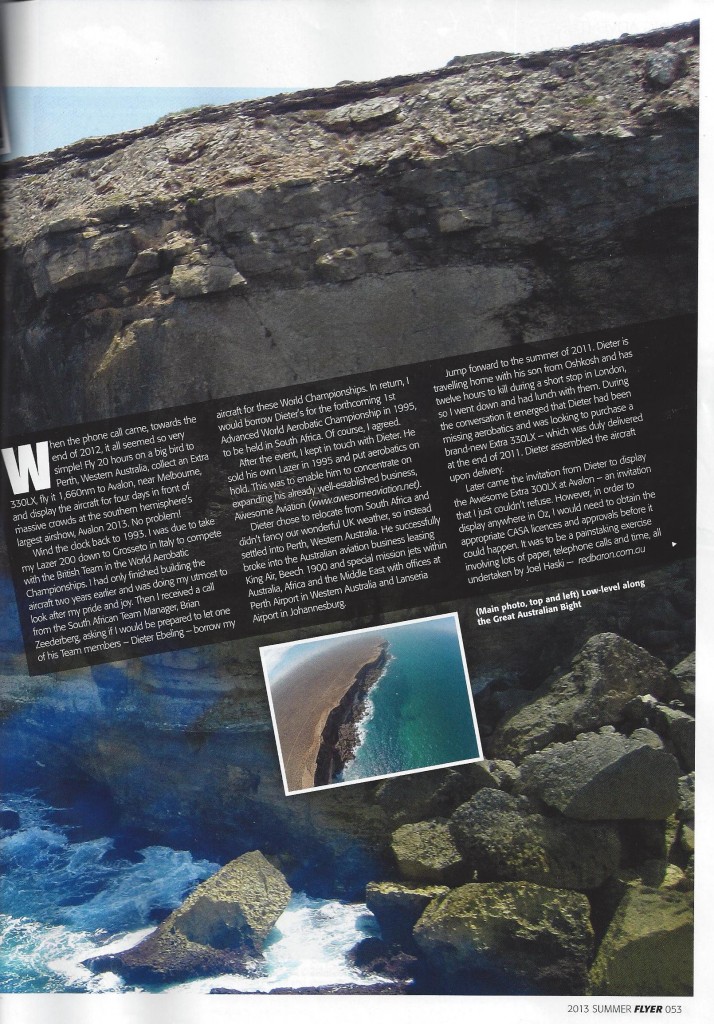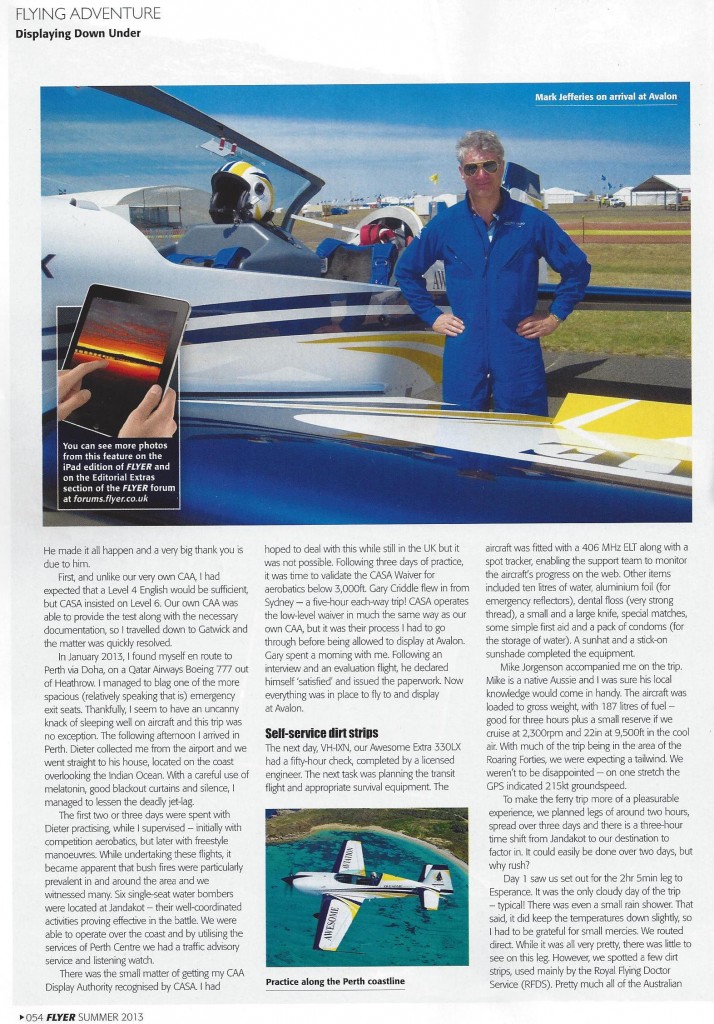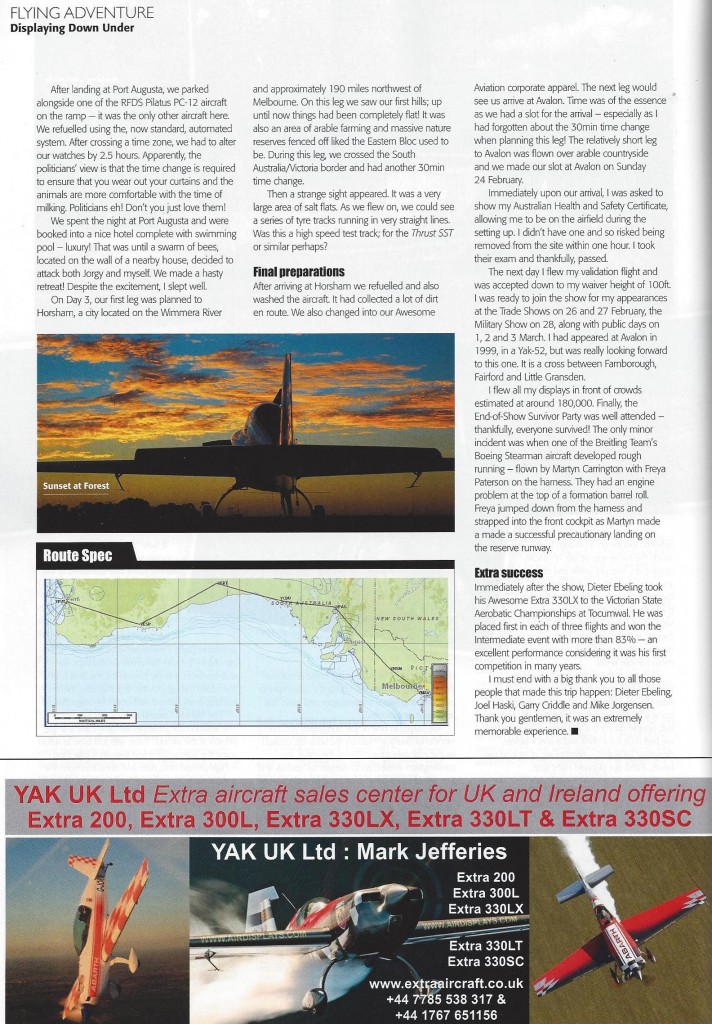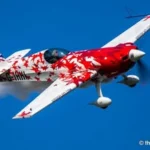Displaying Down Under
Mark Jeffries, former UK Unlimited Aerobatic Champion recalls his recent trip to Oz to display a new Extra 330LX at the Avalon Air Show
When the phone call came, towards the end of 2012, it all seemed so very simple! Fly 20 hours on a big bird to Perth, Western Australia, collect an Extra 330LX, fly it 1,660nm to Avalon, near Melbourne, and display the aircraft for four days in front of massive crowds at the southern hemisphere’s largest airshow, Avalon 2013. No problem!
Wind the clock back to 1993. I was due to take my Lazer 200 down to Grosseto in Italy to compete with the British Team in the World Aerobatic Championships. I had only finished building the aircraft two years earlier and was doing my utmost to look after my pride and joy. Then I received a call from the South African Team Manager, Brian Zeederberg, asking if I would be prepared to let one of his Team members – Dieter Ebeling – borrow my aircraft for these World championships. In return, I would borrow Dieter’s for the forthcoming 1st Advanced World Aerobatic Championship in 1995, to be held in South Africa. Of course, I agreed.
After the event, I kept in touch with Dieter. He sold his own Lazer in 1995 and put aerobatics on hold. This was to enable him to concentrate on expanding his already well established business, Awesome Aviation (www.awesomeaviation.net). He chose to relocate from South Africa and didn’t fancy our wonderful UK weather, so instead settled into Perth, Western Australia. He successfully broke into the Australian aviation business leasing King Air’s, Beech 1900’s and Special Mission Jets within Australia, Africa and the Middle-East with offices at Perth Airport in Western Australia and Lanseria Airport in Johannesburg.
Jump forward to the summer of 2011. Dieter is travelling home with his son from Oshkosh and has twelve hours to kill during a short stop in London, so I went down and had lunch with them. During the conversation it emerged that Dieter had been missing aerobatics and was looking to purchase a brand-new Extra 330LX – which was duly delivered at the end of 2011. Dieter assembled the aircraft upon delivery.
Later came the invitation from Dieter to display the Awesome Extra 300LX at Avalon – an invitation that I just couldn’t refuse. However, in order to display anywhere in Oz, I would need to obtain the appropriate CASA licenses and approvals before it could happen. It was to be a painstaking exercise involving lots of paper, telephone calls and time all undertaken by Joel Haski (http://redbaron.com.au). He made it all happen and a very big thank you is due to him.
Firstly, and unlike our very own CAA, I had expected that a level 4 English would be sufficient, but CASA insisted on Level 6. Our own CAA was able to provide the test along with the necessary documentation so I travelled down to Gatwick and the matter was quickly resolved.
In January 2013, I found myself en-route to Perth via Doha, on a Qatar Airways Boeing 777 out of Heathrow. I managed to blag one of the more-spacious (relatively speaking that is!) emergency exit seats. Thankfully, I seem to have an uncanny knack of sleeping well on aircraft and this trip was no exception. I fell asleep on pushback!
The following afternoon I arrived in Perth, Dieter collected me from the airport and we went straight to his house, located on the coast overlooking the Indian Ocean. With a careful use of Melatonin, good black-out curtains and silence, I managed to lessen the deadly jet-lag and fell into a regular sleep pattern while in Oz.
The first two-three days were spent with Dieter practicing while I supervised – initially with competition aerobatics, but later with freestyle manoeuvres. While undertaking these flights, it became apparent that bush fires were particularly prevalent in and around the area and we witnessed many. Six single-seat water bombers were located at Jandakot and appeared to be on a constant rotation to and from the fires – their well co-ordinated activities proving effective in their battle.
We were able to operate over the coast and by utilising the services of Perth Centre we had a traffic advisory service and listening watch.
There was the small matter of getting my CAA Display Authority recognised by CASA. I had hoped to deal with this while still in the UK but it was not possible. Following three days of practice, it was time to validate the CASA Waiver for aerobatics below 3,000-feet. Gary Criddle flew in from Sydney (check a map to see just how far he journeyed); a five hour each-way trip! CASA operates the Low-level waiver in much the same way as our own CAA and, according to the CAA it does migrate around the world. CASA takes a different view however, and I had to go through their process before being allowed to display at Avalon. Gary spent a morning with me and following an interview and an evaluation flight, he declared himself ‘satisfied’ with my flying and issued the paperwork there and then. Now everything was in place to fly to and display at Avalon.
The next day, VH-IXN, our Awesome Extra 330LX had a fifty-hour check, completed by a licensed engineer, although my own knowledge of the type was useful in expediting the process.
The next task was planning the transit flight and appropriate survival equipment. The aircraft was fitted with a 406 Mhz ELT along with a spot tracker, enabling the support team to monitor the aircraft’s progress on the web. In addition, they would be notified of each departure, the length of each leg, duration and destination; and could activate the emergency services on our behalf, if required.
Other items packed under the ‘survival’ banner included ten litres of water stored in twenty half-litre bottles all tied together by string and stored carefully within the aircraft. Also carried in a small waterproof box were some pieces of aluminium foil (for emergency reflectors), dental floss (very strong thread), a small and a large knife, special matches, some simple first aid and a pack of condoms (for the storage of water). A mobile ‘phone was also carried but there were very large areas of the route where coverage was not going to be possible. Finally, a sun hat and a stick-on sun shade completed the equipment.
I was accompanied on the trip by Mike Jorgenson. Mike is a native ‘Aussie’ and I was sure his local knowledge would come in handy at some stage. The aircraft was loaded to gross weight, with 187 litres of fuel – good for three hours plus a small reserve if we cruise at 2,300rpm and 22-inches at 9,500-feet in the cool air. With much of the trip being in the area of the Roaring Forties, we were expecting a tail wind. We weren’t to be disappointed; with a TAS of 160-170 knots, the GPS usually indicated a ground speed well above that – on one stretch it made 215 knots!
I had really enjoyed my short stay in Perth. I was taken by just how clean everything is; and how warm! The sky was clear blue every day! Most evenings were spent outside on the balcony and white parrots flew around in flocks – just like our own UK-resident pigeons. I didn’t recognise a single bird song during my time here!
To make the ferry trip more of a pleasurable experience, we planned legs of around two hours, spread over three days and there is a three-hour time shift from Jandakot to our destination to factor in. It could easily be done over two days, but why rush?
Day 1 saw us set out for the two-hour, five-minute leg to Esperance. It was the only cloudy day of the trip – typical! There was even a small rain shower – I had thought I had left them all back home. That said, it did keep the temperatures down slightly, so I had to be grateful for small mercies. We routed direct while it was all very pretty, there was little to see on this leg. However, we spotted a few dirt strips, used mainly by the Royal Flying Doctor Service (RFDS), such an important aspect of Australian Aviation. Pretty much all of the Australian airfields operate on a Unicom basis, much the same way as our American cousins do. You just prefix and end your transmission with the name of the airfield you are talking to – simple! It effectively provides pilot-controlled separation. What is does mean is that there is usually someone listening on the frequency, reassuring in some of the more remote areas.
Our stay at the dirt strip of Esperance was brief. Like most of the airstrips across Australia, refuelling is a self-service arrangement using a BP Credit Card as payment. We saw only two people during our visit here. After refuelling, we had time for a drink, a snack and time to stretch our legs before departing for Forest – another leg of around two hours – and our planned night stop.
This leg was across the Nullabor Plain and we planned to fly at 10,000-feet. The Nullarbor Plain is part of the area of flat, almost treeless, arid country of southern Australia, located on the Great Australian Bight coast with the Great Victoria Desert to its north. It is the world’s largest single piece of limestone, and occupies an area of about 200,000 square kilometres. At its widest point, it stretches 684 miles from east to west between South Australia and Western Australia. For many Australians ‘Crossing the Nullarbor’ is a quintessential experience of the ‘Australian Outback‘. Stickers bought from roadhouses on the highway show ‘I have crossed the Nullarbor’, and can be seen applied to vehicles of varying quality or capacity for long distance travel. For us, high above the ground, the en-route scenery was often barren but spectacular.
Forest is unusual among airfield in Australia. It is one of very few privately-owned, ex-military airfields and is equipped with an NDB and a single hanger. It is located alongside the longest stretch of straight railway in Oz. Due to its desolate location, it has a resident airfield manager who completes a 12-month stint at the airfield. The town of Forest consists of just six bungalows, all located adjacent to the runway, which sees between one and twenty movements a month. The population of Forest is just three – the airfield manager, his wife and a single employee!
When visiting airfields like Forest, it is customary to arrive bearing gifts – a newspaper and fresh fruit are always appreciated.
We stayed in one of the bungalows and had a wonderful evening meal on the veranda, cooked by the airfield manager’s wife. During the meal, the conversation moved on to dangerous spiders and the airfield manager grabbed a powerful torch and shone it around the immediate area. Less than 10 metres from our table were numerous pairs of eyes from the deadly Trap Door spiders; as well as five dingoes seen a little further away, eating one of their dead colleagues. At times, the smell was rather unpleasant. After a great meal and interesting conversation, I retired to the bungalow and slept well!
For Day 2, we had planned a 10am start – that was, until a Bristow’s helicopter crew arrived and we chatted with them. Departure slipped to 11am. Our next destination was Ceduna and we planned a slight detour to view the Great Australian Bight. Ceduna is situated in the northwest corner of Eyre Peninsula, in the West Coast region of South Australia. It lies west of the junction of the Flinders and Eyre Highways around 500-miles northwest of the capital Adelaide.
It meant we would be flying with desert to our left and the coast line to our right – the flat desert is 150-feet amsl with a rugged cliff top down to the water below; clearly a case of desert to the left and sharks to the right!
It was spectacular but I must admit to feeling just a little unnerved at the time. The desert is empty and you are on your own. While flying along the coastline, the nearest land mass to the south is Antarctica! Once passed the Great Australian Bight, it becomes golden sandy beaches – for mile upon mile – although we didn’t witness a single person on any stretch of the beach throughout this leg! That said, the en-route scenery proved well worth the slight detour.
The flight to Ceduna took us just 1 hour, 45-minutes. The isolation continued as we didn’t see a single person at the airfield. There was just time to refuel using the auto system and take on a little food – high-protein bars, nuts and dried fruit from the survival pack. It was just as well we had this sustenance in the survival pack as no food was available on the airfield.
Next stop on the journey was Port Augusta – a seaport and railway junction city on the east coast of the Eyre Peninsula in South Australia, at the head of the Spencer Gulf, 200 miles north of the state capital. Once again, the scenery below was changing; now it was moving from being just a barren desert, as occasional arable farming areas appeared; although there was still mile-upon-mile of sand dunes separating the land mass from the sea. There were few, if any, place to complete a forced landing. The beaches appeared to be soft sand, the desert was scrub and rocks and what roads did occasionally appear were unmade and single-track.
After landing at Port Augusta, we parked alongside one of the RFDS Pilatus PC-12 aircraft on the ramp – it was the only other aircraft here. We refuelled using the, now standard, automated system. After crossing a time zone, we had to alter our watches by 2.5 hours. Apparently, the politicians view is that the time change is required to ensure that you wear out your curtains and the animals are more comfortable with the time of milking. Politicians eh! Don’t you just love them!
We spent the night at Port Augusta and were booked into a nice hotel complete with swimming pool – luxury! That was until a swarm of bees located on the wall of a nearby house decided to attack both Jorgy and myself. We made a hasty retreat! Despite the excitement, I slept well.
On Day 3, our first leg was planned to Horsham, a city located on the Wimmera River and approximately 190 miles north-west of Melbourne. On this leg we saw our first hills; up until now things had been completely flat! It was also an area of arable farming and massive nature reserves fenced off liked the Easter Bloc used to be. During this leg, we crossed the South Australia/Victoria border and had another 30-minute time change.
Then a strange sight appeared. It was a very large area of salt flats. As we flew on, we could see a series of tyre tracks running in very straight lines. Was this a high speed test track; for the Thrust SST or similar perhaps?
After arriving at Horsham we refuelled and also washed the aircraft. It had collected a lot of dirt en-route. We also changed into our Awesome Aviation corporate apparel. The next leg would see us arrive at Avalon. Time was of the essence as we had a time slot for the arrival – especially as I had forgotten about the 30-minute time change when planning this leg!
The relatively short leg to Avalon was flown over arable countryside and we made our slot at Avalon on Sunday 24th February.
Immediately upon our arrival I was asked to show my Australian Health and Safety Certificate, allowing me to be on the airfield during the setting up. I didn’t have one and so risked being removed from the site within one hour. I took their exam and thankfully, passed.
The next day I flew my validation flight and was accepted down to my waiver height of 100-feet. I was ready to join the show for my appearances at the Trade Shows on the 26th and 27thFebruary, the Military Show on the 28th, along with public days on the 1st 2nd and 3rd March. I had appeared at Avalon in 1999, in a Yak-52, but was really looking forward to this one. It is a cross between Farnborough, Fairford and Little Gransden.
I flew all my displays in front of crowds estimated at around 180,000. Finally, the End-of-Show Survivor Party was well attended – thankfully, everyone survived! The only minor incident was when one of the Breitling Team’s Boeing Stearman aircraft developed rough running – flown by Martyn Carrington with Freya Paterson on the harness – had an engine problem at the top of a formation barrel roll. Freyer jumped down from the harness and strapped into the front cockpit as Martyn made a precautionary landing on the reserve runway.
Immediately after the show, Dieter Ebeling took his Awesome Extra 330LX to the Victorian State Aerobatic Championships at Tocumwal. He was placed first in each of three flights and won the Intermediate event with more than 83% – an excellent performance considering it was his first competition in many years.
I had half-a-day in Melbourne before joining a QATAR flight back to Doha (14 hours) and on to London (another 7.5 hours). On the flight home I managed to catch a cold from one or more of my fellow travellers – be it back packers or grumpy teenagers – on the flight. What is more, during my time in Oz, I never even saw a kangaroo or a Koala Bear!
I have to end with a big ‘thank you’ to all those people that made this trip happen: Dieter Ebeling, Joel Haski, Garry Criddle and Mike Jorgensen. Thank you gentlemen, it was extremely memorable.








 WhatsApp me
WhatsApp me
You must be logged in to post a comment.